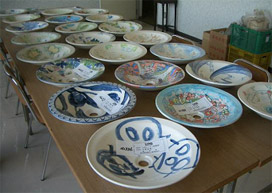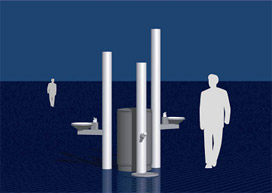New life for old ceramic: Drinking fountain bowls made of recycled ceramic
- These fountains are installed at 28 locations in both Nagakute and Seto Areas -
Separate waste collection has taken root in many areas in Japan. For example, beverage containers are classified into PET bottles, aluminum and steel cans, and glass bottles. Some local governments further separate glass bottles by color. These containers are collected as recyclables, and recycled to make new products used in daily life.
Among the eating utensils used in daily life, how are broken ceramic cups and plates classified and disposed of? According to a survey conducted by a certain local government, about 0.5 – 1.0 kilograms of waste ceramic is produced per person annually, a total of 140,000 tons of ceramic (including that for industrial/commercial waste) being discarded every year in Japan. Most of this waste ceramic is collected as noncombustible waste and buried in final disposal sites. Since ceramic utensils can be used repeatedly, the amount of waste ceramic is smaller than that of used beverage containers mentioned above. However, it is also a fact that 140,000 tons of waste ceramic goes into landfills annually as noncombustible waste.
Seto City, site of EXPO 2005 Aichi, Japan, is one of Japan’s major ceramic production centers, as its name suggests (the Japanese word for ceramic - setomono - is named after the City). In Seto City, a project is under way for recycling broken ceramic (the percentage of porcelain is higher than that of earthenware) into new ceramic products: broken ceramic is crushed into fine particles, which are then mixed with ceramic clay at the ratio of 50%; the resulting material is then used to create new ceramic products. Although technology for blending crushed ceramic with clay at a ratio of about 10 - 25% was already available, using existing production techniques it was impossible to mix crushed ceramic at a ratio of 50%. This required the development of new techniques as well as new production equipment. On the basis of the Ecological Declaration (Environmental Principles) proposed by the Japan Association for the 2005 World Exposition, Seto City, in cooperation with the Association, has fostered the development of such technologies as part of the project to embody the zero-emission concept. The technology developed under this project has yielded various eco-friendly solutions, including the following.
(1) Reduction in amount of landfill waste
(2) Securing “clay,” a resource of the ceramic industry, for a longer period of time
(3) Lower kiln temperature for firing ceramics. Generally, ceramic is fired at a temperature of around 1,300°C. However, the technology developed under this project has made it possible to lower the firing temperature to 1,150°C, realizing energy consumption cuts of up to 40% as compared to conventional consumption, as well as reducing CO2 emissions.
(This 150°C temperature reduction is quite significant, since energy consumption increases sharply beyond 1,000°C.)

Fountain bowls to be used at EXPO 2005 Aichi, Japan

Conceptual rendering of public drinking fountain
At the Exhibition sites, water fountain bowls made of recycled ceramic will be installed on 28 public drinking fountains, in pairs (one at a higher level, one at a lower: 56 fountain bowls in total). The citizens of Seto City decorated these fountain bowls and fired them. In addition to visitor enjoyment of the decorations, the bowls will demonstrate Seto City’s efforts toward Development for Eco-Communities.
Earthenware and porcelain
Do you know the difference between Toki (earthenware) and Jiki (porcelain)? The Japanese often call these two together “Tojiki (ceramic).” According to an official from the Aichi Ceramic Industry Union (located in Seto City), the difference is as follows:
- Earthenware: Made of pottery clay containing about 40% stone. Makes a dull sound when struck. Absorbs a little water.
- Porcelain: Made of pottery clay containing about 60% stone. Makes a clear, metallic sound when struck. Hardly absorbs water.
Although both are fired at a temperature of around 1,300°C, it is easy to understand the difference if you picture earthenware as a tea ceremony bowl, and porcelain as a white eating utensil with a smooth surface.


